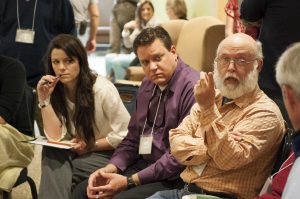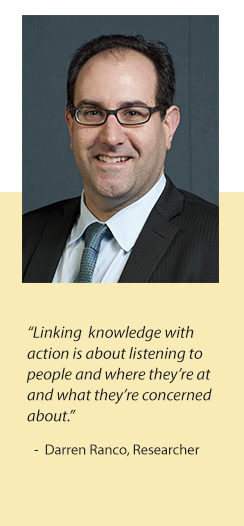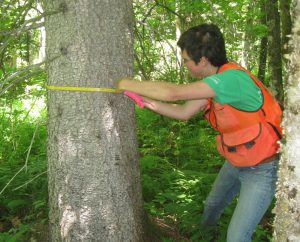Drawing on Local Knowledge to Build Better Solutions

Mitchell Center researchers are tackling diverse problems, but all of them are committed to close collaboration with stakeholders throughout the research process. Every project is rooted in the understanding that the people, agencies, and organizations dealing with sustainability challenges have expertise and insights that researchers lack—information that is key to finding effective and sustainable solutions.
The process begins with listening, says Darren Ranco, Chair of Native American Programs, Director of Native American Research at UMaine and a member of the Penobscot Indian Nation, who is leading a team to help Maine prepare for a likely invasion of the emerald ash borer (EAB). This insect threatens to decimate the state’s ash trees, which are at the center of culture, art, and livelihood for Maine’s renowned Indian basketmakers.
“Linking knowledge with action is about listening to people and where they’re at and what they’re concerned about,” Ranco says. “We’re mutual learners. We have some knowledge and expertise, but everyone else does as well—basketmakers, ash harvesters and other tribal members, along with foresters and tribal, state and federal agencies. Our question is: how do we mobilize all these different forms of knowledge to actually solve a problem? No one community or group can do that alone. It takes all of us working together.”
concerned about,” Ranco says. “We’re mutual learners. We have some knowledge and expertise, but everyone else does as well—basketmakers, ash harvesters and other tribal members, along with foresters and tribal, state and federal agencies. Our question is: how do we mobilize all these different forms of knowledge to actually solve a problem? No one community or group can do that alone. It takes all of us working together.”
The emerald ash borer team and their partners are creating an innovative “safety net” to help protect the State’s ash trees from the destructive insect, which in 2014 was found within 35 miles of the Maine border in Loudon and Salem, NH, and North Andover, MA. Ranco’s team has established guidelines to help tribal and state agencies develop coordinated emergency response plans, which outline steps for fighting a borer invasion, from monitoring and control to communication and quarantines. These plans are the first in the U.S. to be developed in collaboration with tribes before the borer arrives.
The team’s work continues with a new research project focused on adapting to an EAB invasion. “With EAB’s imminent arrival in Maine, we are continuing our project so that all of our partners work together in a collaborative manner to respond to the potential devastation, and we will also seek ways in which we can all work together to adapt to its arrival,” Ranco says.

To that end, the EAB team will launch pilot projects to evaluate ways to store brown ash materials, locate and secure access for harvesting ash trees in new locations, and document traditional methods of identifying and harvesting basket-quality ash trees to ensure that these techniques are available for future generations. “Throughout the process, we will continue to meet and share lessons learned,” Ranco says.
Funding to support new research on adaptation to an EAB invasion has been provided by the Elmina B. Sewall Foundation and the Northeastern States Research Cooperative.
